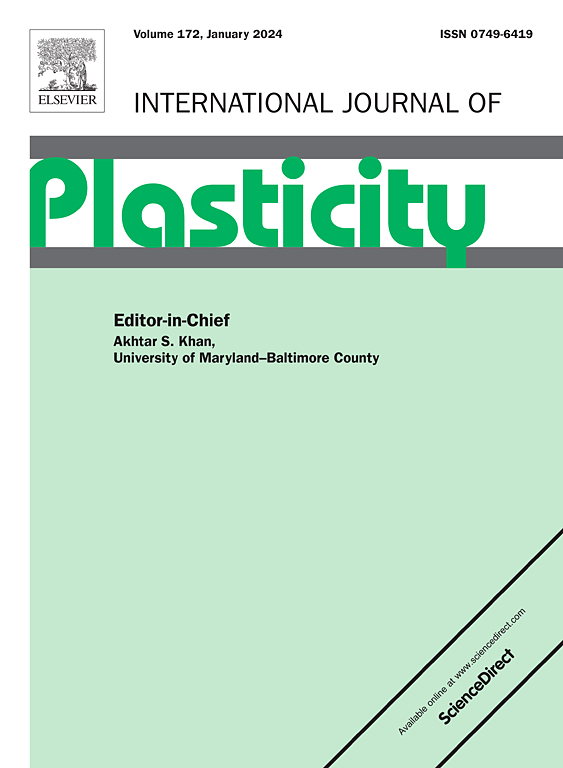Revealing the mechanism for enhancing the creep property by adding Ta/Zr elements in RAFM steel: Experimental and modeling study
IF 12.8
1区 材料科学
Q1 ENGINEERING, MECHANICAL
引用次数: 0
Abstract
A continuum damage mechanics (CDM) creep model was developed based on the microstructure, which could precisely delineate the evolution of mobile dislocations, dipole dislocations, boundary dislocations, and martensitic laths in the RAFM steel during creep process. The addition of Ta/Zr elements promoted the precipitation of MX carbide particles, which could pin the mobile dislocations, and restrain the transformation of mobile dislocations into dipole dislocations, thereby slowing the decrease in statistically stored dislocation (SSD) density during creep. A large number of fine MX and M23C6 carbide particles sourcing from the addition of Ta/Zr elements could effectively delay the reduction in geometrically necessary dislocation (GND) density, and restrict GNDs transforming into sub-grain boundaries. By manipulating single-factor variables, the increase in precipitate damage factors strongly affected the steady creep stage and accelerated creep stage, especially for the precipitate damage factor of M23C6, which significantly accelerates the onset of the accelerated creep stage. The higher coarsening rate of M23C6 in RAFM steel without Ta/Zr was one of the reasons for its premature creep failure, as comparing with RAFM steel with Ta/Zr. During short-term (< 1000 h) creep, fine Laves phase functions similarly to M23C6 particles, serving the purpose of precipitation strengthening. In the intermediate-term (< 10,000 h) creep process, the Laves phase undergoes a certain degree of coarsening, but the coarsening-induced cavities damage is still not the primary cause of creep fracture. Thus, it was inferred that the depletion of W elements in the matrix sourcing from the coarsening of Laves phase is the main reason for the premature creep failure. In the intermediate-term creep of RAFM steel, the ability of Ta/Zr elements to significantly reduce the coarsening rate of Laves is a key factor for contributing to the significant extension of creep rupture time for RAFM steel.
揭示在RAFM钢中添加Ta/Zr元素提高蠕变性能的机理:实验和模型研究
基于微观结构建立了连续损伤力学(CDM)蠕变模型,该模型能够准确描述RAFM钢蠕变过程中移动位错、偶极位错、边界位错和马氏体板条的演变过程。Ta/Zr元素的加入促进了MX碳化物颗粒的析出,可以固定移动位错,抑制移动位错向偶极位错的转变,从而减缓蠕变过程中统计存储位错(SSD)密度的下降。由于Ta/Zr元素的加入而产生的大量细小的MX和M23C6碳化物颗粒可以有效地延缓几何必要位错(GND)密度的降低,并限制GNDs向亚晶界的转变。通过操纵单因素变量,析出相损伤因子的增加强烈影响稳态蠕变阶段和加速蠕变阶段,尤其是M23C6的析出相损伤因子的增加,显著加速了加速蠕变阶段的开始。与含Ta/Zr的RAFM钢相比,不含Ta/Zr的RAFM钢中M23C6的粗化率较高是其过早蠕变失效的原因之一。在短期内(<;1000 h)蠕变时,细小的Laves相功能类似于M23C6颗粒,起到沉淀强化的作用。中期而言(<;10,000 h)蠕变过程中,Laves相发生了一定程度的粗化,但粗化引起的空洞损伤仍不是蠕变断裂的主要原因。由此可以推断,Laves相粗化导致基体中W元素的耗损是导致材料过早蠕变破坏的主要原因。在RAFM钢的中期蠕变过程中,Ta/Zr元素显著降低Laves粗化速率的能力是RAFM钢蠕变破裂时间显著延长的关键因素。
本文章由计算机程序翻译,如有差异,请以英文原文为准。
求助全文
约1分钟内获得全文
求助全文
来源期刊

International Journal of Plasticity
工程技术-材料科学:综合
CiteScore
15.30
自引率
26.50%
发文量
256
审稿时长
46 days
期刊介绍:
International Journal of Plasticity aims to present original research encompassing all facets of plastic deformation, damage, and fracture behavior in both isotropic and anisotropic solids. This includes exploring the thermodynamics of plasticity and fracture, continuum theory, and macroscopic as well as microscopic phenomena.
Topics of interest span the plastic behavior of single crystals and polycrystalline metals, ceramics, rocks, soils, composites, nanocrystalline and microelectronics materials, shape memory alloys, ferroelectric ceramics, thin films, and polymers. Additionally, the journal covers plasticity aspects of failure and fracture mechanics. Contributions involving significant experimental, numerical, or theoretical advancements that enhance the understanding of the plastic behavior of solids are particularly valued. Papers addressing the modeling of finite nonlinear elastic deformation, bearing similarities to the modeling of plastic deformation, are also welcomed.
 求助内容:
求助内容: 应助结果提醒方式:
应助结果提醒方式:


